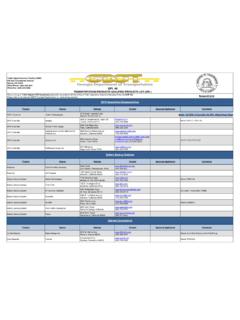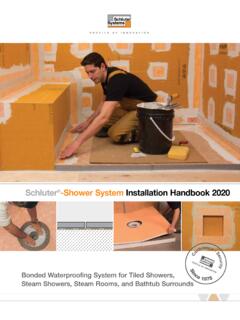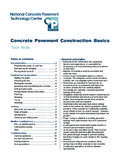Transcription of Model Music Curriculum - GOV.UK
1 Model Music Curriculum : Key Stages 1 to 3 Non-statutory guidance for the national Curriculum in England March 2021 2 Foreword If it hadn t been for the classical Music played before assemblies at my primary school or the years spent in school and church choirs, I doubt that the joy I experience listening to a wide variety of Music would have gone much beyond my favourite songs in the UK Top 40. I would have heard the wonderful melodies of Carole King, Elton John and Lennon & McCartney, but would have missed out on the beauty of Handel, Beethoven and Bach, the dexterity of Scott Joplin, the haunting melody of Clara Schumann s Piano Trio in G, evocations of America by Dvo k and Gershwin and the tingling mysticism of Allegri s Miserere.
2 The Model Music Curriculum is designed to introduce the next generation to a broad repertoire of Music from the Western Classical tradition, and to the best popular Music and Music from around the world. This Curriculum is built from the experience of schools that already teach a demanding and rich Music Curriculum , produced by an expert writing team led by ABRSM and informed by a panel of experts great teachers and musicians alike and chaired by Veronica Wadley. I would like to thank all involved in producing and contributing to this important resource. It is designed to assist rather than to prescribe, providing a benchmark to help teachers, school leaders and Curriculum designers make sure every Music lesson is of the highest quality.
3 In setting out a clearly sequenced and ambitious approach to Music teaching, this Curriculum provides a roadmap to introduce pupils to the delights and disciplines of Music , helping them to appreciate and understand the works of the musical giants of the past, while also equipping them with the technical skills and creativity to compose and perform. Having the opportunity to study and explore Music is not a privilege; it is a vital part of a broad and ambitious Curriculum . I therefore encourage all schools to use this Curriculum , working with their Music Education Hubs to provide a quality Music education for their pupils, to ensure every child develops a life-long love of Music and musical performance.
4 Rt Hon Nick Gibb MP Minister of State for School Standards 3 Contents The Model Music Curriculum 4 Introduction to the Model Music Curriculum 4 Introduction to Key Stages 1 & 2 7 Model Music Curriculum Key Stage 1 12 Key Stage 1 Year 1 Guidance 13 Key Stage 1 Year 2 Guidance 16 Model Music Curriculum Key Stage 2 19 Key Stage 2 Year 3 Guidance 22 Key Stage 2 Year 4 Guidance 25 Key Stage 2 Year 5 Guidance 29 Key Stage 2 Year 6 Guidance 33 Model Music Curriculum Key Stage 3 37 Key Stage 3 Year 7 Guidance 46 Key Stage 3 Year 8 Guidance 49 Key Stage 3 Year 9 Guidance 52 Year 9 Culmination Project The Blues 55 Appendix 1 Key Stages 1 & 2 Glossary 56 Appendix 2 Chronology: Repertoire in Context 61 Appendix 3 Key Stages 1 & 2 Foundation Listening and Case Studies 74 Appendix 4 Key Stage 3 Foundation Listening 87 Appendix 5 Case Study of Integrated Learning in Years 3 6 95 Appendix 6 Year 6 to Year 7 Transition Project 98 Appendix 7 Sources of Information and Support 99 Appendix 8 Statutory Guidance 102 4 The Model Music Curriculum The 2021 Model Music Curriculum (MMC) sits at the heart of the Government s agenda for supporting Curriculum Music in schools during Key Stages 1, 2 and 3.
5 The Curriculum development has been teacher led, with input from leading musicians and education sector bodies. The power of Music Music is all around us. It is the soundtrack to our lives. Music connects us through people and places in our ever-changing world. It is creative, collaborative, celebratory and challenging. In our schools, Music can bring communities together through the shared endeavour of whole-school singing, ensemble playing, experimenting with the creative process and, through the love of listening to friends and fellow pupils, performing. The sheer joy of Music making can feed the soul of a school community, enriching each student while strengthening the shared bonds of support and trust which make a great school.
6 The aim of the Model Music Curriculum The aim of the MMC is to ensure a universal provision of Music education, for all pupils in all schools. In time and resources, this provision is as follows: At Key Stages 1 and 2, pupils should receive a minimum of one hour of teaching a week; this may take the form of short sessions spread across the week. In Years 3 or 4, it is recommended that each class should start a whole-class instrumental programme lasting a minimum of one term. The mandatory term will be supported by teachers from the local Music Education Hub. Opportunities for development should continue beyond the mandatory term. There should be access to both rhythmic and melodic instruments in Key Stages 1 and 2; this may be as part of the whole-class instrumental programme and/or in other classroom teaching.
7 Music should have a minimum of one weekly period the whole way through Key Stage 3. Carousels are not a substitute that fits with the values of comprehensive education. Introduction to the Model Music Curriculum Beyond the statutory requirements The MMC is a non-statutory resource that provides a practical framework through which the statutory requirements of the Curriculum can be met. By setting out a Model of how the Curriculum can be delivered, it offers guidance and ideas for teachers, and provides a springboard from which to approach teaching. The MMC complements the National Plan for Music Education and is intended to be used by specialist and non-specialist Music teachers at Key Stages 1 and 2 (Primary level), building on an Early Years Foundation, and by specialist Music teachers in Key Stage 3 (Secondary level).
8 It has been developed with this in mind to provide a strong 5 core set of competencies and shared knowledge. Many schools will want to go well beyond this core and to use it to supplement current practice. Special Educational Needs and Disability (SEND) Music has a rare and unique ability to bring people together; Music making can make a whole class, school and community feel connected to others and part of something bigger. This MMC celebrates the inclusion of pupils with special educational needs and disabilities as it does the leaps in technology that have made available new tools and adapted instruments, leading to improved access and greater choice for all pupils to realise their creative potential.
9 The National Curriculum Inclusion Statement states that teachers should set high expectations for every pupil, whatever their prior attainment. Teachers should use appropriate assessment to set targets which are deliberately ambitious. Potential areas of difficulty should be identified and addressed at the outset. Lessons should be planned to address potential areas of difficulty and to remove barriers to pupil achievement. Using the MMC The MMC sets out sequences of learning in the following key areas which, when taken together, all contribute towards the steadily increasing development of musicianship: Singing Listening Composing Performing/Instrumental Performance Within each of these areas are some suggested repertoire choices to support teachers in delivering the Curriculum and, in the appendices, suggested approaches to demonstrate the way in which musical listening, meaning, performance and composition are linked.
10 Progression through the Key Stages The MMC takes as its starting point the ambition that every young person should be able to experience Music and to make progress. It is founded on the belief that Music enriches individual lives as well as a school s wider community. The MMC aims to support all pupils in their musical progression through the Key Stages. By offering a rich and varied musical framework that nurtures fundamental musical techniques alongside building musical knowledge, it offers a clear pathway towards mature musical understanding. Staff notation not only complements developing aural skills, improvisation, memorisation and composition, but also provides the opportunity for pupils to be taught Music independently both in class and after they have left school.














